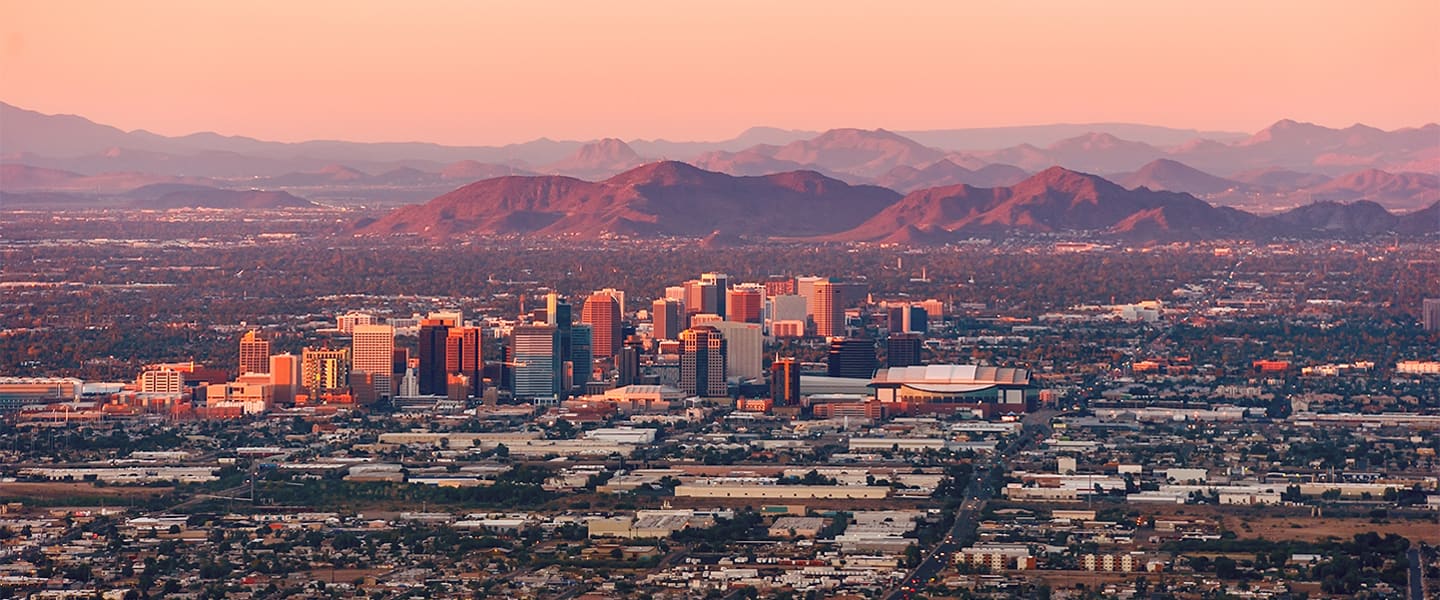Senior Apartments in Arizona

Overview of Senior Apartments in Arizona
When people picture an ideal retirement scenario, Arizona is often what comes to mind. “The Grand Canyon State” has an abundance of warm, dry weather — which means anyone who suffers from seasonal allergies or asthma will find relief in Arizona’s desert climate — and its almost otherworldly natural landscapes provide countless opportunities for outdoor activities, exercise, and serenity. The trails throughout national parks like Saguaro and Petrified Forest capture the rugged mystique of the Southwest, and don’t worry, there’s no shortage of golf courses. Plus, considering the state doesn’t tax residents on social security income, it’s clear why so many Americans find peace of mind — and body — while retiring in Arizona.
Currently, Arizona has more than 25 home care agencies that provide home health aides for seniors who live alone at home. A Place for Mom’s Senior Living Advisors can provide you with a list of home care services in Arizona to help you find one that fits your needs and budget.
The median monthly cost of home care in Arizona is about $4,800, according to Genworth.
Top-rated Senior Apartments facilities in Arizona
Revel Scottsdale
Revel Scottsdale is an extremely welcoming and friendly place, where intelligent, active seniors engage in numerous activities (like bridge, scrabble, mah jong, cards, fitness workouts, trivia contests,...
Revel McDowell Mountain
Restaurant staff is very nice and friendly. Yes, we would recommend Revel McDowell Mountain to other families based on the experience so far.
Mera City Center
The office staff are friendly and helpful. The maintenance staff are prompt and thorough. The grounds are well cared for and the common areas are cleaned every day. The apartments are larger than the floor...
Top-rated Senior Apartments facilities in Scottsdale
See top facilitiesRevel Scottsdale
Revel Scottsdale is an extremely welcoming and friendly place, where intelligent, active seniors engage in numerous activities (like bridge, scrabble, mah jong, cards, fitness workouts, trivia contests,...
Revel McDowell Mountain
Restaurant staff is very nice and friendly. Yes, we would recommend Revel McDowell Mountain to other families based on the experience so far.
Mera City Center
The office staff are friendly and helpful. The maintenance staff are prompt and thorough. The grounds are well cared for and the common areas are cleaned every day. The apartments are larger than the floor...
Top-rated Senior Apartments facilities in Phoenix
See top facilitiesAmberlin Arrowhead
JUST A FABULOUS PLACE TO RESIDE* IT IS IMMACULATE TO LIVE HERE *THE GROUNDS &THE MAINTENANCE TRAM WORK TIRELESSLY TO KEEP UP WITH THE ESSENCE OF THE FACILITY* SENIORS ARE CONSTANTLY INVOLVED IN SOME...
Revel Scottsdale
Revel Scottsdale is an extremely welcoming and friendly place, where intelligent, active seniors engage in numerous activities (like bridge, scrabble, mah jong, cards, fitness workouts, trivia contests,...
Top-rated Senior Apartments facilities in Mesa
See top facilitiesSage Mesa
I was happy living alone there as an "active senior." Yes, prompt daily apartment-door trash pickup. Very friendly and janitorial was good. Building is in good repair, and relatively new. Not provided;...
Albany Apartments
I was very happy to find this hidden treasure of a place. I was skeptical because of the location but this has really been a great place! It’s very well managed, maintained and clean! It’s well lit and my...
Revel Scottsdale
Revel Scottsdale is an extremely welcoming and friendly place, where intelligent, active seniors engage in numerous activities (like bridge, scrabble, mah jong, cards, fitness workouts, trivia contests,...
Top-rated Senior Apartments facilities in Chandler
See top facilitiesMera Chandler
All Categories above are rated "5" with special recognition for [names removed], Assistant Mgr-they are both so kind & helpful. Activities here are wonderful. Our Maintenance Crew is great.
Revel Scottsdale
Revel Scottsdale is an extremely welcoming and friendly place, where intelligent, active seniors engage in numerous activities (like bridge, scrabble, mah jong, cards, fitness workouts, trivia contests,...
Sage Mesa
I was happy living alone there as an "active senior." Yes, prompt daily apartment-door trash pickup. Very friendly and janitorial was good. Building is in good repair, and relatively new. Not provided;...
Top cities in Arizona for senior apartments
Find senior apartments in other states
Find Senior Apartments in Arizona cities
Other senior living options in Arizona
Find assisted living near you
The information contained on this page is for informational purposes only and is not intended to constitute medical, legal or financial advice or create a professional relationship between A Place for Mom and the reader. Always seek the advice of your health care provider, attorney or financial advisor with respect to any particular matter, and do not act or refrain from acting on the basis of anything you have read on this site. Links to third-party websites are only for the convenience of the reader; A Place for Mom does not endorse the contents of the third-party sites.
Please enter a valid email address.
A Place for Mom is paid by our participating communities, therefore our service is offered at no charge to families. Copyright © 2024 A Place for Mom, Inc. All Rights Reserved. Privacy & Terms. Do Not Sell My Personal Information.